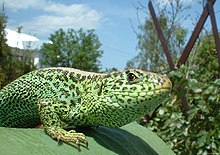
Lizards are a widespread group of squamate reptiles, with over 7,000 species, ranging across all continents except Antarctica, as well as most oceanic island chains. The group is paraphyletic since it excludes the snakes and Amphisbaenia although some lizards are more closely related to these two excluded groups than they are to other lizards. Lizards range in size from chameleons and geckos a few centimeters long to the 3-meter-long Komodo dragon.

The Lepidosauria is a subclass or superorder of reptiles, containing the orders Squamata and Rhynchocephalia. Squamata includes snakes, lizards, and amphisbaenians. Squamata contains over 9,000 species, making it by far the most species-rich and diverse order of reptiles in the present day. Rhynchocephalia was a formerly widespread and diverse group of reptiles in the Mesozoic Era. However, it is represented by only one living species: the tuatara, a superficially lizard-like reptile native to New Zealand.

Squamata is the largest order of reptiles, comprising lizards, snakes, and amphisbaenians, which are collectively known as squamates or scaled reptiles. With over 10,900 species, it is also the second-largest order of extant (living) vertebrates, after the perciform fish. Members of the order are distinguished by their skins, which bear horny scales or shields, and must periodically engage in molting. They also possess movable quadrate bones, making possible movement of the upper jaw relative to the neurocranium. This is particularly visible in snakes, which are able to open their mouths very wide to accommodate comparatively large prey. Squamates are the most variably sized living reptiles, ranging from the 16 mm (0.63 in) dwarf gecko to the 6.5 m (21 ft) Reticulated python. The now-extinct mosasaurs reached lengths over 14 m (46 ft).

Amphisbaenia is a group of usually legless squamates, comprising over 200 extant species. Amphisbaenians are characterized by their long bodies, the reduction or loss of the limbs, and rudimentary eyes. As many species have a pink body and scales arranged in rings, they have a superficial resemblance to earthworms. While the genus Bipes retains forelimbs, all other genera are limbless. Although superficially similar to the snakes, legless lizards, and blind lizards, recent phylogenetic studies suggest that they are most closely related to wall lizards of the family Lacertidae. Amphisbaenians are widely distributed, occurring in North America, Europe, Africa, South America, Western Asia and the Caribbean. Most species are less than 6 inches (15 cm) long.

Dibamidae or blind skinks is a family of lizards characterized by their elongated cylindrical body and an apparent lack of limbs. Female dibamids are entirely limbless and the males retain small flap-like hind limbs, which they use to grip their partner during mating. They have a rigidly fused skull, lack pterygoid teeth and external ears. Their eyes are greatly reduced, and covered with a scale.
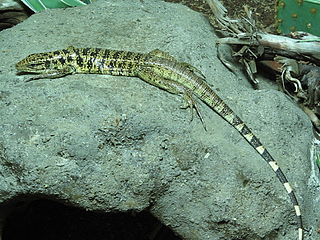
Teiidae is a family of autarchoglossan lizards native to the Americas. Members of this family are generally known as whiptails or racerunners; however, tegus also belong to this family. Teiidae is sister to the Gymnopthalmidae, and both families comprise the Teiioidea. The Teiidae includes several parthenogenic species – a mode of clonal reproduction. Presently, the Teiidae consists of approximately 150 species in eighteen genera.
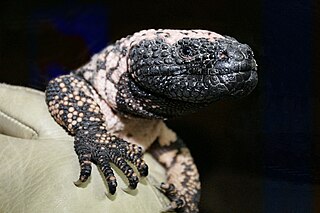
Heloderma is a genus of toxicoferan lizards that contains five species, all of which are venomous. It is the only extant genus of the family Helodermatidae.

Toxicofera is a proposed clade of scaled reptiles (squamates) that includes the Serpentes (snakes), Anguimorpha and Iguania. Toxicofera contains about 4,600 species, of extant Squamata. It encompasses all venomous reptile species, as well as numerous related non-venomous species. There is little morphological evidence to support this grouping, however it has been recovered by all molecular analyses as of 2012.
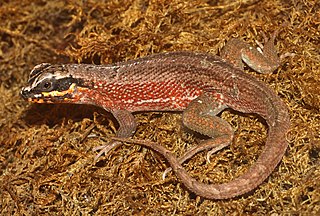
Iguania is an infraorder of squamate reptiles that includes iguanas, chameleons, agamids, and New World lizards like anoles and phrynosomatids. Using morphological features as a guide to evolutionary relationships, the Iguania are believed to form the sister group to the remainder of the Squamata, which comprise nearly 11,000 named species, roughly 2000 of which are iguanians. However, molecular information has placed Iguania well within the Squamata as sister taxa to the Anguimorpha and closely related to snakes. The order has been under debate and revisions after being classified by Charles Lewis Camp in 1923 due to difficulties finding adequate synapomorphic morphological characteristics. Most Iguanias are arboreal but there are several terrestrial groups. They usually have primitive fleshy, non-prehensile tongues, although the tongue is highly modified in chameleons. The group has a fossil record that extends back to the Early Jurassic. Today they are scattered occurring in Madagascar, the Fiji and Friendly Islands and Western Hemisphere.
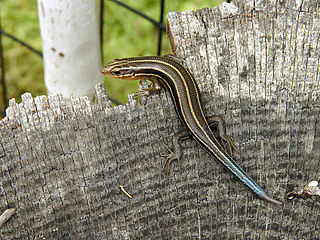
Autarchoglossa is a clade of squamates that includes skinks, anguimorphs, snakes, and relatives. Autarchoglossa is supported as a monophyletic grouping by morphological features in living and extinct lizards and snakes. Some phylogenetic analyses based on molecular features such as DNA sequences in living squamates do not support Autarchoglossa.

Scincomorpha is an infraorder and clade of lizards including skinks (Scincidae) and their close relatives. These include the living families Cordylidae, Gerrhosauridae, and Xantusiidae, as well as many extinct taxa. Other roughly equivalent terms include the suborder Scinciformata, or the superfamily Scincoidea, though different authors use these terms in a broader or more restricted usage relative to true skinks. They first appear in the fossil record about 170 million years ago, during the Jurassic period. The phylogeny below follows that of Alifanov in 2016.
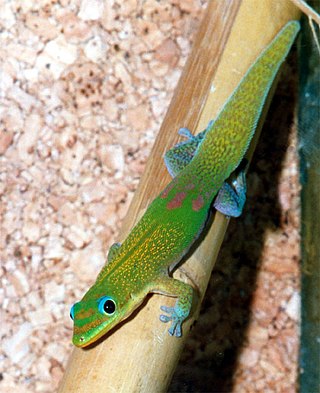
Scleroglossa is a group of lizards that includes geckos, autarchoglossans, and amphisbaenians. Scleroglossa is supported by phylogenetic analyses that use morphological features. According to most morphological analyses, Scleroglossa is the sister group of the clade Iguania, which includes iguanas, chameleons, agamids, and New World lizards. Together, Scleroglossa and Iguania make up the crown group Squamata, the smallest evolutionary grouping to include all living lizards and snakes.

Platynota is a polyphyletic group of anguimorph lizards and thus belongs to the order Squamata of the class Reptilia. Since it was named in 1839, it has included several groups, including monitor lizards, snakes, mosasaurs, and helodermatids. Its taxonomic use still varies, as it is sometimes considered equivalent to the group Varanoidea and other times viewed as a distinct group. It is phylogenetically defined as a clade containing Varanidae. It also includes many extinct species.

Cryptolacerta is an extinct genus of lacertoid lizard which lived during the Eocene epoch in what is now Germany. It is known from a nearly complete and articulated skeleton including the skull, which was found in the Messel Pit locality of Germany. Cryptolacerta was named by Johannes Müller, Christy A. Hipsley, Jason J. Head, Nikolay Kardjilov, André Hilger, Michael Wuttke and Robert R. Reisz in 2011 and the type species is Cryptolacerta hassiaca. Cladistic analysis conducted by Müller et al. suggests that Cryptolacerta is a sister taxon to Amphisbaenia. However, later studies questioned its closeness to that group, and suggested that the similarities could be convergent due to both groups having a similar burrowing lifestyle, and it may be more closely related to Lacertidae instead.
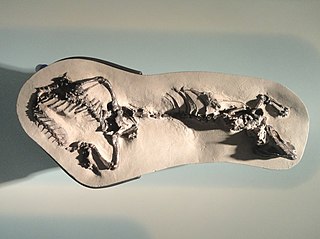
Polyglyphanodontia, also known as the Borioteiioidea, is an extinct clade of lizards from the Cretaceous that includes around a dozen genera. Polyglyphanodontians were the dominant group of lizards in North America and Asia during the Late Cretaceous. Most polyglyphanodontians are Late Cretaceous in age, though the oldest one, Kuwajimalla kagaensis, is known from the Early Cretaceous Kuwajima Formation (Japan). Early Cretaceous South American taxon Tijubina, and possibly also Olindalacerta, might also fall within Polyglyphanodontia or be closely allied to the group, but if so, they would be two of only three Gondwanan examples of an otherwise Laurasian clade. They produced a remarkable range of forms. Chamopsiids, including Chamops, were characterized by large, blunt, crushing teeth, and were most likely omnivores. Macrocephalosaurus, from the Gobi Desert, was a specialized herbivore; it grew to roughly a meter long and had multicusped, leaf-shaped teeth like those of modern iguanas. Polyglyphanodon, from the Maastrichtian of Utah, was another herbivore, but its teeth formed a series of transverse blades, similar to those of Trilophosaurus. Peneteius had remarkable, multicusped teeth, similar to those of mammals. The polyglyphanodontids first appear in the latter part of the Early Cretaceous in North America, and became extinct during the Cretaceous-Paleogene extinction event. Polyglyphanodontians closely resembled the teiid lizards, and purported teiid lizards from the Late Cretaceous appear to be polyglyphanodontians. The only species known to have survived the Cretaceous was Chamops, which survived until the very early Ypresian.
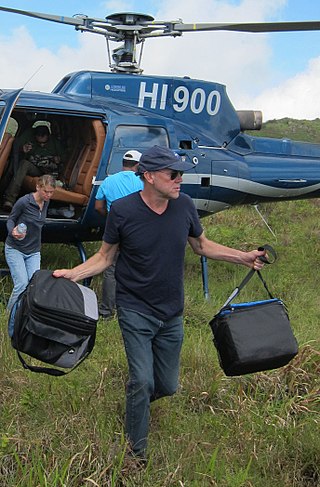
Stephen Blair Hedges is Laura H. Carnell Professor of Science and director of the Center for Biodiversity at Temple University where he researches the tree of life and leads conservation efforts in Haiti and elsewhere. He co-founded Haiti National Trust.

The Amerophidia, also known as amerophidian snakes, are a superfamily of snakes that contains two families: Aniliidae and the boa-like Tropidophiidae.

Neoanguimorpha is a clade of anguimorphs comprising Monstersauria and Diploglossa. Morphological studies in the past had classified helodermatids with the varanoids in the clade Platynota, while the Chinese crocodile lizard was classified as a xenosaurid. However molecular work found no support in these groupings and instead has found the helodermatids more related to Diploglossa, while the Chinese crocodile lizard and varanoids to form the clade Paleoanguimorpha.
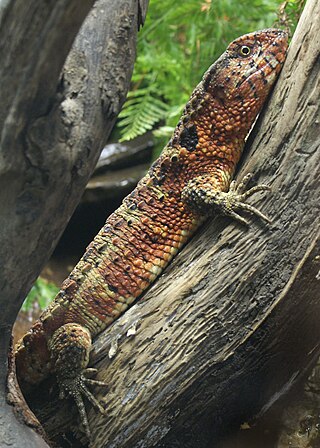
Paleoanguimorpha is a clade of anguimorphs comprising Shinisauria and Goannasauria. Morphological studies in the past also classified helodermatids and pythonomorphs with the varanoids in the clade Platynota, while the Chinese crocodile lizard was classified as a xenosaurid. Current molecular work finds no support in these groupings and instead has found the helodermatids more related to Diploglossa in the sister clade Neoanguimorpha, while the Chinese crocodile lizard is the closet living relative to varanoids. Pythonomorphs represented by snakes today are not closely related to varanoids and are instead a sister lineage to Anguimorpha and Iguania in the clade Toxicofera.

Diploglossa is a clade of neoanguimorphs represented by the families Xenosauridae, Diploglossidae, Anniellidae and Anguidae, the latter three placed in the superfamily Anguioidea. In the past the Chinese crocodile lizard was classified as a xenosaurid; current molecular work has shown evidence the species related to varanoids in the clade Paleoanguimorpha.
